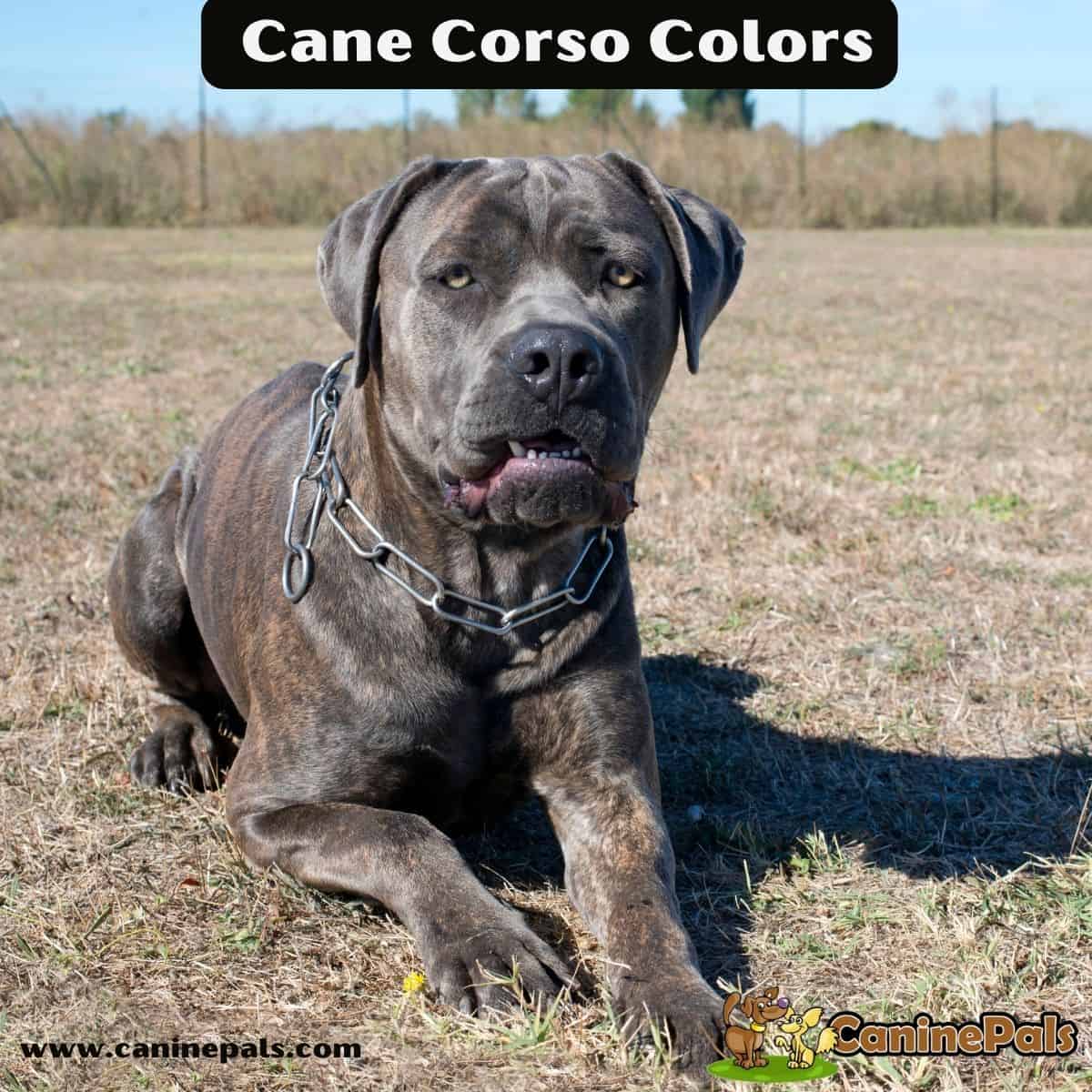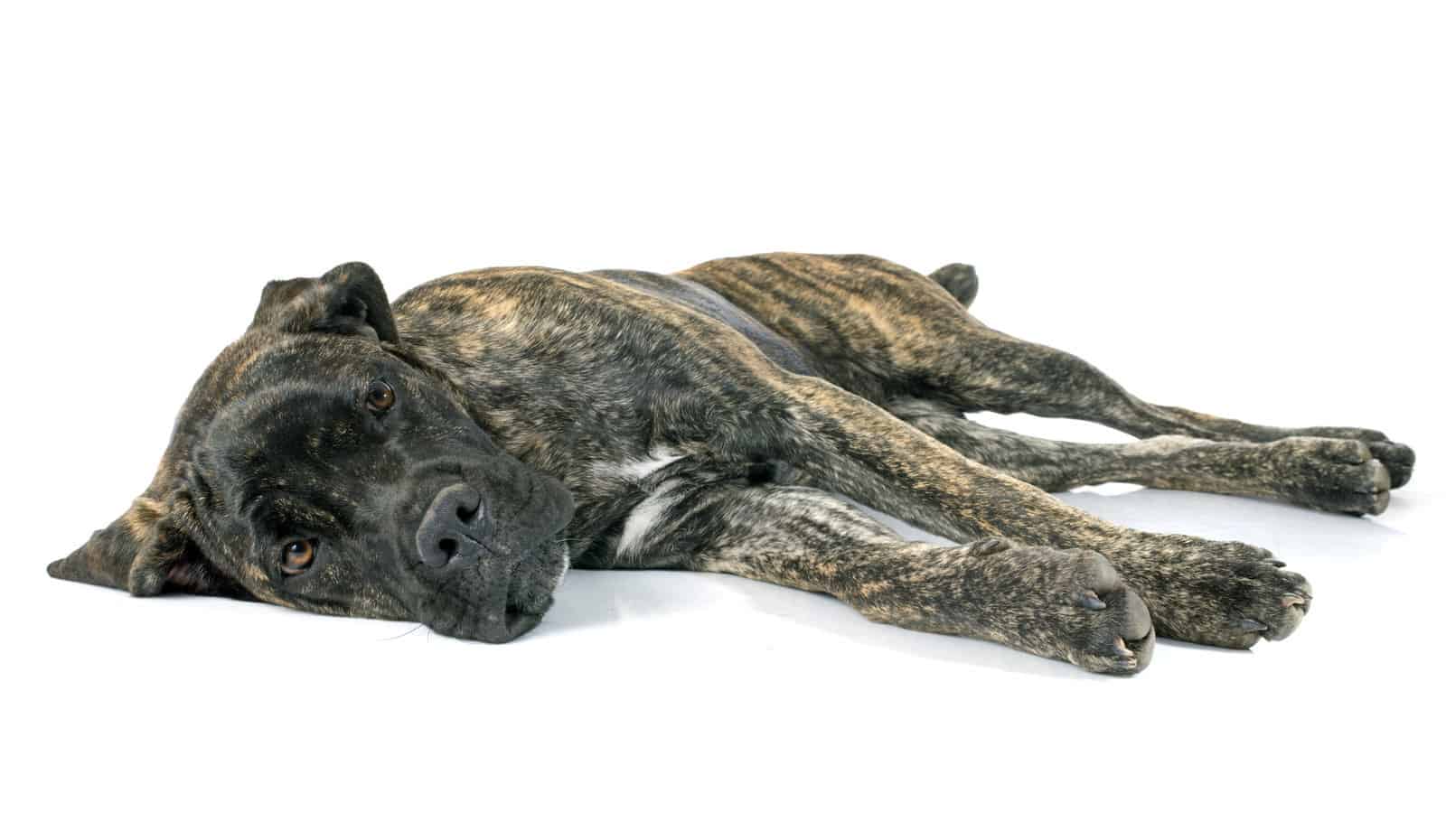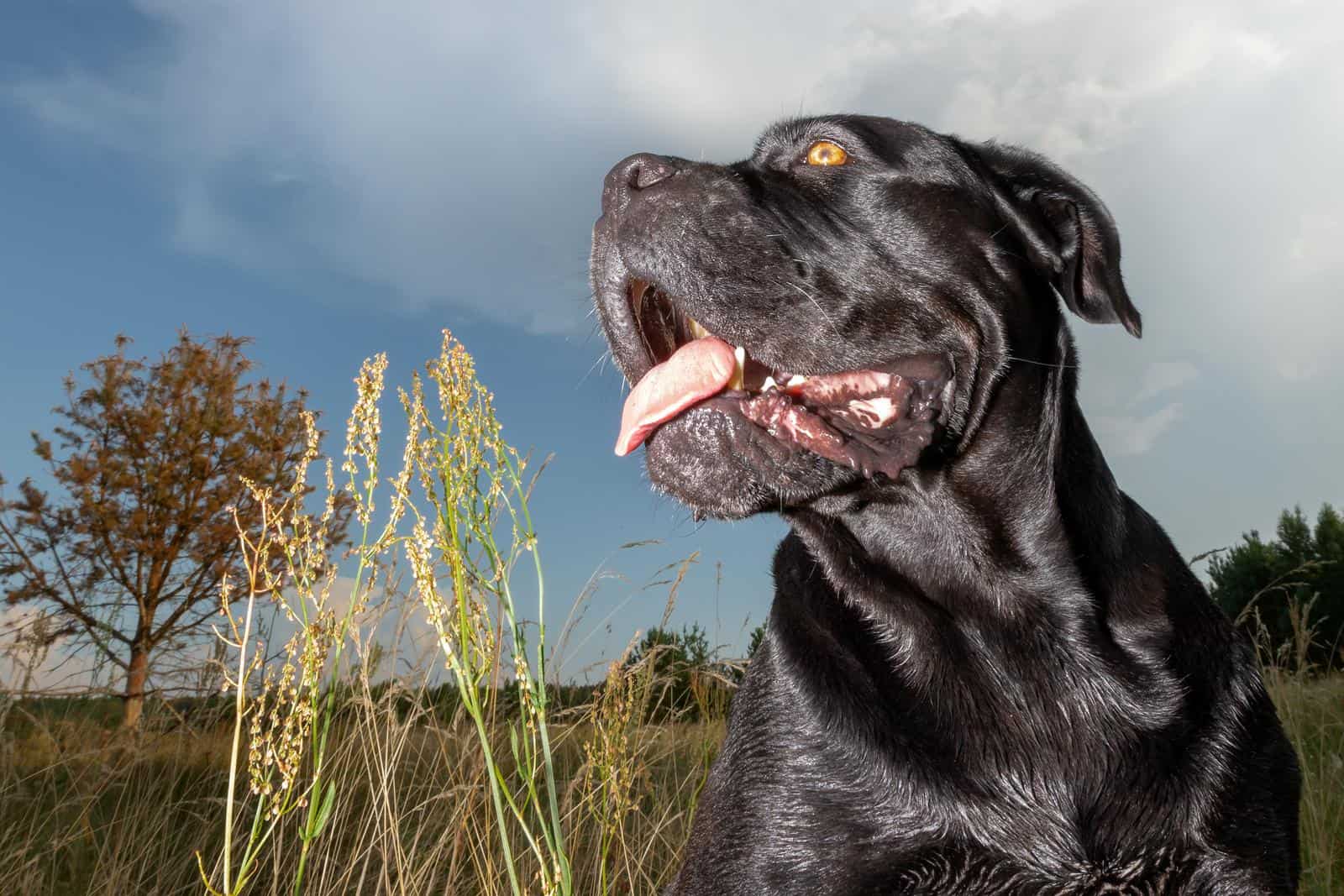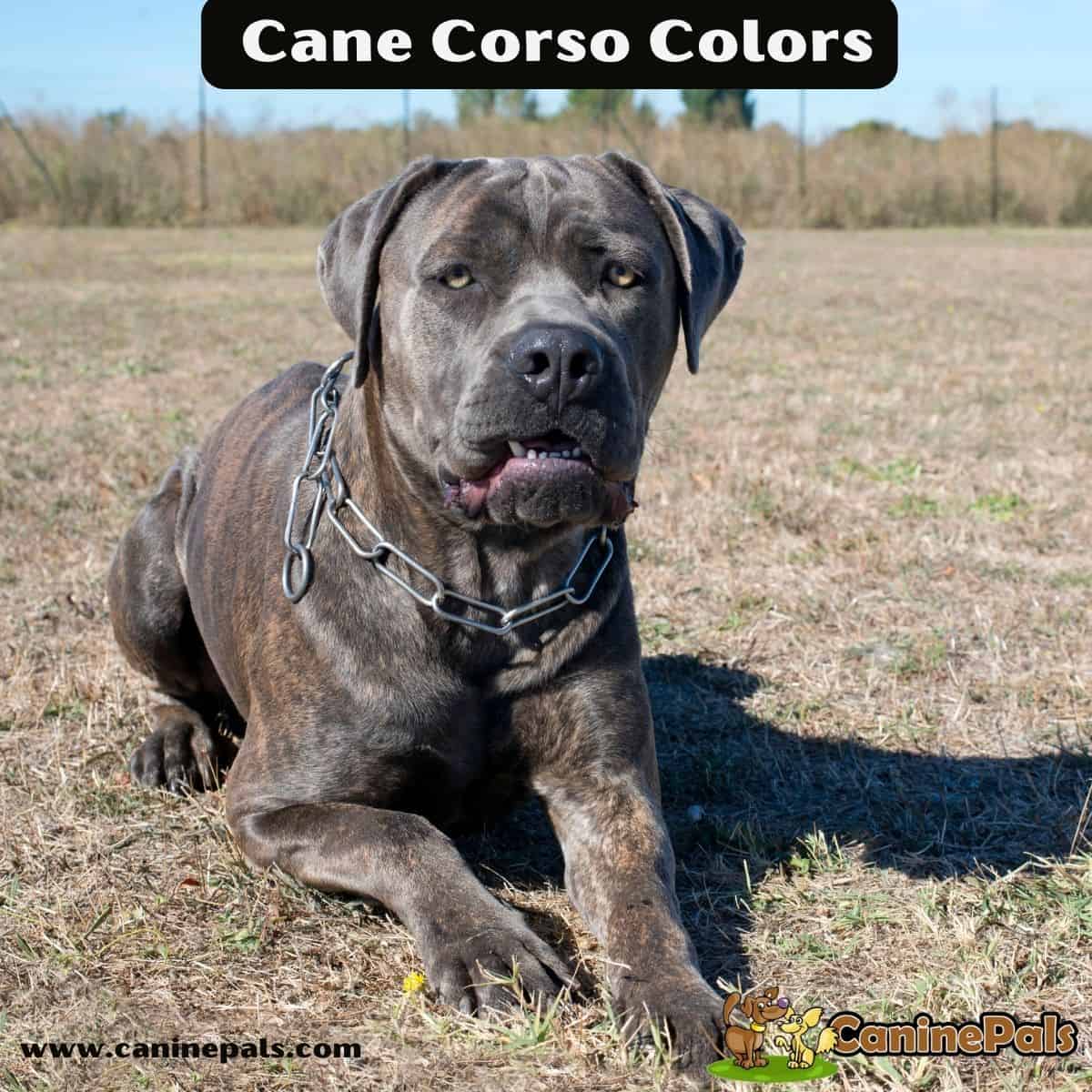Last Updated on March 8, 2024 by Denise Leo. Post first published on February 1, 2023.
The Cane Corsos, also known as Italian Mastiffs, are athletic, agile, energetic, and powerful dogs that are gentle and affectionate with their family. They stand out wherever they go, and you can’t even walk down the street without drawing stares and having people ask to pet them.
Corsos certainly make a statement, and there’s no doubt about that! Their distinctiveness can extend to their remarkable coat colors as well.
Picking a color for your Cane Corso can be one of the first big decisions! We’re going to take a look at different Cane Corso colors and the differences in each.
Quick Facts About Cane Corso Colors
- Cane Corsos come in seven officially recognized colors: black, black brindle, gray, gray brindle, fawn, red, and chestnut brindle.
- Black Corsos have a deep coat that shines in the sunlight and is ideal for show dogs or watchdogs.
- The other colors range from cream to brownish tan, with various masking shades around their eyes.
- There are also unofficial Cane Corso colors such as blue/gray (dilute black pigment), chocolate/liver (solid brown version of a black Corso), and Isabella/tawny which is not considered an official color by AKC due to its recessive genes causing it to be prone to diseases.
- Puppies can change color over time, but they won’t turn into a completely different color on the opposite end of the spectrum than what they were born with – just subtle changes like darkening or lightening occur over time as markings shrink or expand slightly when reaching maturity age.
- Ultimately, no ‘best’ Cane Corso color is solely about personal preference! Health & temperament should always remain a top priority when considering adopting one.

What Colors Do Cane Corsos Come In?
Why settle for just one color type of Cane Corso when you can have several?
While Cane Corsos come in various colors and patterns, only seven breed colors are officially recognized by the American Kennel Club (AKC). These colors are black, black brindle, gray, gray brindle, fawn, red, and chestnut brindle.
Take a look at the Cane Corso color chart:
| Coat Color | AKC Accepted? |
| Black | Yes |
| Black Brindle | Yes |
| Gray | Yes |
| Gray Brindle | Yes |
| Fawn | Yes |
| Red | Yes |
| Chestnut Brindle | Yes |
| Isabella | No |
| Chocolate/ Liver | No |
| Formentino | No |
Let’s look at each coat color in more depth:
Black
You might think that this coat color of Cane Corsos would be boring, but these dogs have such deep, rich coats that they’re incredibly striking. These are stunning dogs, plain and simple. Other notable features of a black Cane Corsos are their black nose and brown eyes. They tend to have more airy undercoats compared with brindles or fawns.
Black color is produced through one of the two pigments in dogs, called eumelanin. A healthy black coat will shimmer brilliantly in direct sunlight. So, this coat color is particularly useful for show dogs as it helps to accentuate the Corso’s impressive musculature. Black Corso’s intimidating appearance will also make it an ideal watchdog.
Black Brindle
Brindle black Corsos are known for their brown or red base and their brindle “tiger stripes,” which are black. This is a normal coloration for Corsos and doesn’t indicate any genetic anomaly.
Black Brindle Corsos have the longest life span among other breed colors. They were often used for hunting and described as tiger-striped dogs with huge jaws. In Italy, this coloration is referred to as ‘tigrato.’
Gray
Gray Corsos get their coat color from the recessive dilute gene(d), which inhibits the eumelanin production in a Corso’s coat. The dilute(d) recessive gene in Corsos will dilute black pigment to gray. The gray color is produced when Corso parents carry this dilute gene and pass it on to their offspring. Many breeders also call the gray shade ‘blue.’
The gray coat color is highly sought after and prized by many Corso lovers. Gray Corso puppies may lighten or darken as they mature.
Gray Brindle
They have a brown base color, like the black brindle, and their stripes are grayish or blue. Their coat patterns appear blotchy at times but appear stunning like other Corso puppies. Gray brindle Corsos rarely have any brindling on the tips of their muzzles. These dogs have a longer life expectancy than their solid-colored cousins.
Fawn
Fawn Corsos are very popular due to their striking appearance. Fawn Corso coats range from cream to brownish tan. Any shade of fawn, from light cream to brownish tan, is acceptable by AKC.
Fawn is a gorgeous color that extends almost across the dog’s entire body. Most fawn Corsos have a black or gray mask, which means the coloring around their face is much darker than the rest of their body. The black or gray mask doesn’t go beyond their eyes. Some white markings on the throat, chin, chest, or pasterns are also acceptable.
Red
The Red Cane Corso coat is developed through the pigment called pheomelanin. This red pigment concentration varies through different genetic pathways and results in an array of red shades.
Some Corsos have a deep mahogany shade, while others possess a pale champagne color. Red Corsos have a black or gray mask around their eyes, which are highly pigmented on their muzzles. Some red Cane Corso puppies are born with a black or blue saddle mark which fades as they mature.
Chestnut Brindle
The chestnut brindle Corsos are another striped dog variety but are not as common as the black and gray brindle. This is because they can be challenging to breed.
Chestnut brindle Corsos have a brown or red tone for their base, and their stripes are saturated reddish-brown. The stripes can vary from light to heavy and are sometimes difficult to distinguish from the black brindle. In dim lighting, they almost appear like a black brindles. However, the difference is very much visible in natural light.
Do Blue Cane Corsos Exist?
According to AKC, the blue Cane Corso doesn’t exist. Instead of using blue to label a dilute of black pigment, they named the coat color gray.
Some breeders and pet owners address their Corso with a steely-gray tone as blue Cane Corso. Blue and gray are used interchangeably by most Corso lovers. Perhaps it’s simply because blue sounds more exotic and exciting than gray. Gray Corsos also have a dilute gene that causes them to appear gray instead of black.

What Is The Rarest Cane Corso Color?
In addition to the seven officially recognized Cane Corso coat colors, there are several unofficial colors. However, the ones above are the only official Cane Corso colors.
Most of the other potential shades are gorgeous and mishmashes the official colors. These coat colors are uncommon because they are a result of recessive genes. They don’t indicate crossbreeding, as they can occur without genetic manipulation.
-
Blue Fawn/ Formentino
A dilution of the fawn coloration, the Formentino Corso has a carbon-colored coat with a blue or gray nose and mask in addition to gray patches over his shoulders and back. They have unusual light-colored eyes too. Formentino Corsos have a lower life expectancy of 8 years and are prone to skin conditions.
-
Chocolate/ Liver
These dogs have a solid chocolate or liver base color and look like the brown version of a black Cane Corso. Chocolate Corsos have a pinkish tone around their eyes and nose. They usually have green hazel eyes, which gives them a striking appearance.
-
Isabella/ Tawny
Isabella, tawny, or lilac coat is highly sought after but is considered a severe fault in Cane Corsos. They have a pinkish tinge to their noses, lips, and eyelids and often have green hazel eyes like the chocolate Corso. Tawny Corsos are more susceptible to diseases, such as Color Dilution Alopecia which can cause hair loss and skin irritation.

Why Do Corsos Have Many Different Coat Colors?
Two types of pigments determine the color of Cane Corsos. The dark pigment is called “Eumelanin,” and the light pigment is called “Phaeomelanin.” These two pigments create all different color variations.
Eumelanin’s default color is black and codes for the black color spectrum. It can turn brown, gray, and pale brown when diluted. When modified, Phaeomelanin produces red, orange, gold, cream, tan, and other colors. Eumelanin is responsible for the color of the Cane Corso’s coat, eyes, and nose. Meanwhile, phaeomelanin only affects the Corso’s coat color.
Can Cane Corso Puppies Change Color?
Yes, like many dog breeds, Corso puppies can mature to have different colored coats from the ones they were born with. You’ll see the most significant change in their coats in the first year of life. The changes in their color are subtle, and they won’t turn into color on the opposite end of the spectrum.
Cane Corso puppies born light gray may develop a darker gray coat as they age. However, a black Corso can’t suddenly become fawn or red-colored. Also, when puppies mature, their markings may shrink or expand.

What Is The Best Cane Corso Color?
There is no ‘best’ Cane Corso color – it’s solely a matter of personal preference! No matter what color or pattern their coats are, Cane Corsos are remarkably stunning and regal creatures. While the AKC will tell you that there are only seven legitimate Cane Corso colors, we believe all Corsos are beautiful and equally deserving of love!
Final thoughts: Cane Corso Colors
There’s much more to owning a Cane Corso than just coat color. Adopting a pup shouldn’t be done just on the basis of coat color. While you may have a personal preference for one color over another, the overall health and temperament of the dog are far more important to consider than its color alone.
Regardless of your Cane Corso’s coloration, your pet will be full of life and positivity, and they’re bound to bring you and your family happiness and laughter for many years.
I hope that you found this article informative. Please feel free to leave comments below with any outstanding questions that you may have!
References and Further Reading:


